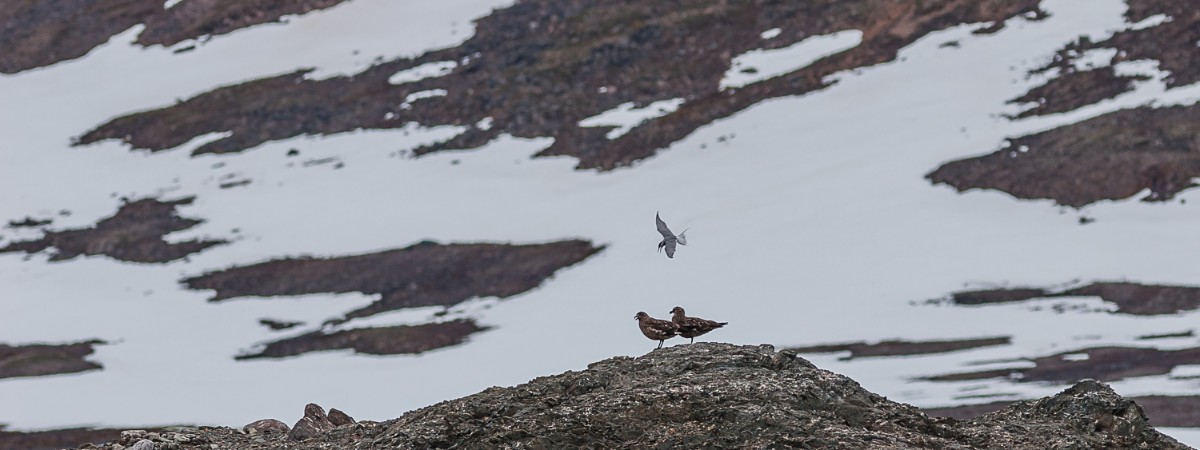Duration of snow cover on land
Last updated 22 April 2025
Snow cover is an indicator of climate change, since it is controlled by both temperature and precipitation. Snow cover is a complex unit to monitor, but at the same time very important both in the ecosystems and the climate system.

What is being monitored?
Duration of snow cover
The figure shows the number of days with recorded snow cover on the ground. There are great variations from year to year, but several stations show a distinct tendency for fewer days with a snow cover since the 2000s compared with the 1970s and 1980s. A reduction in the number of days with snow cover may be due to the rise in the autumn and/or spring temperatures, which will help to bring later snow cover in autumn and earlier snow melting in spring. Trends for Ny-Ålesund and Jan Mayen have not been calculated due to few data points and/or breaks in the time series.
(Cite these data: Norwegian Meteorological Institute (2025). Numbers of days with snow-covered ground. Environmental monitoring of Svalbard and Jan Mayen (MOSJ). URL: https://mosj.no/en/climate/land/duration-snow-cover.html)
Details on these data
| Last updated | 22 April 2025 |
| Update interval | Yearly |
| Next update | February 2026 |
| Executive organization | Norwegian Meteorological Institute |
| Contact persons | Herdis Motrøen Gjelten |
Method
Snow cover (SC) is observed in a radius of 1 kilometre around the station (presuming that the height above sea level is about the same). SC is reported using coded figures of 0–4:
0. No snow
1. Mostly bare ground, but some snow patches
2. Half the ground is snow covered
3. Mostly snow covered ground, but some bare patches
4. Full snow cover
In MOSJ, SC=1 is chosen as the threshold to identify the maximum duration of the snow cover and prevent uneven snow distribution in midwinter caused by strong winds affecting the results. Days when the ground is mainly covered by ice are included.
Snow cover is an estimated assessment made by an observer and the results may be slightly dependent on the person.
Quality
The observations are made in keeping with national and international guidelines for observations of snow cover.
Other metadata
Status and trend
Owing to some gaps in the data series, it is not particularly easy to compare the development of the duration of snow cover between the Norwegian Arctic stations, and it has been impossible to perform robust testing of statistical significance of trends. Hence, we kan only comment on tendencies in the series.
Overall, the data sets show that there are large variations in the snow cover from year to year. In the last fifteen years, the stations have throughout the year between 191 and 319 days with snow- or ice-covered ground. Svalbard Airport has the best data coverage, and presents a clear tendency toward fewer days with snow on the ground after 2006, compared to the 1970s and 1980s. For the period 1976-1997, there was an average of 253 days of snow and ice cover, while for the period 2006-2024 there were 226 days. The time series of Jan Mayen has a large gap, which together with the large natural annual variations makes it difficult to find a tendency, but it seems that there has been some reduction in the duration of snow cover in the latter part of the series. The time series of Ny-Ålesund is too short to comment on tendencies.
Causal factors
A reduction in the number of days with snow cover may be caused by a rise in the autumn and/or spring temperatures, which will help to bring about later snow cover in autumn and earlier snow melting in spring.
Consequences
Changes in snow conditions are expected as a result of the projected future changes in temperature and precipitation in the Arctic. Both temperature and precipitation are expected to rise, and it is by no means certain how the snow conditions will change. Because of this, it is suggested that the basis for snow analyses is improved.
Snow cover duration is monitored for three main reasons:
- Snow-covered ground greatly influences the exchange of energy to the atmosphere, and a systematic change in snow cover duration may intensify changes in climate. The reason is that most of the solar energy is reflected back to space from a snow-covered surface, whereas a snow-free, bare surface absorbs most of the energy as heat. Shorter snow cover duration due to a rise in air temperature and/or less winter precipitation may therefore lead to further warming.
- The snow conditions affect plants and animals in Svalbard. A shorter period of snow cover may prolong the growing season, but it may also damage plants that lack the protection from frost afforded by an insulating layer of snow.
- A shorter period of snow cover in spring may lead to enhanced warming and thawing of the permafrost.
In addition, the economic value of the duration of snow cover in Svalbard is significant in connection with winter tourism, especially in relation to skiing and the use of snowmobiles.
About the monitoring
The length of time snow lies on the ground is monitored because the duration of the snow cover on land is important for a number of elements in the terrestrial ecosystem. Snow-covered ground greatly influences the exchange of energy to the atmosphere and is also a measure of an important feedback mechanism for climate, in that the ability of the ground to reflect (the albedo) is reduced when the snow-covered period is shortened.
Here, snow cover is presented based on visual observations, but snow cover can be monitored over larger areas by satellites.
